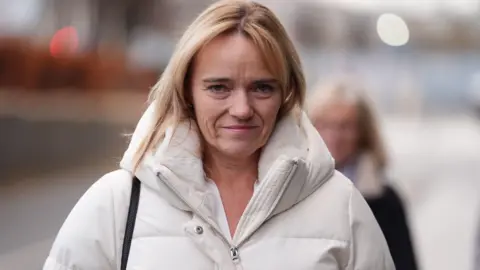Is there a lack of clarity around UK's gender laws?
 PA Media
PA MediaThe Scottish government insists the guidance to public bodies on how single-sex services and spaces should operate is "clear".
But organisations from the prison service to the Rape Crisis network have run into difficulties over their policies.
Meanwhile there's an ongoing tribunal case involving NHS Fife's staff changing rooms.
Nurse Sandie Peggie claims she was subjected to unlawful harassment by being made to share a changing room at Victoria Hospital, Kirkcaldy, with Dr Beth Upton - who is a transgender woman. Ms Peggie's claim is disputed by the health board and the doctor.
This is an issue which has raised questions which have tied politicians in knots and engaged judges right up to the Supreme Court.
What are the relevant laws and guidance which underpin how single-sex spaces work in practice, and why is there such confusion around them?
Which laws apply?
There are a number of laws which can be applied to this area.
On the subject of changing rooms, at the heart of the case in NHS Fife, the Workplace (Health, Safety and Welfare) Regulations 1992 sets out rules for "suitable sanitary conveniences".
One of them is that "separate rooms containing conveniences are provided for men and women", except where all facilities are in separate rooms with a lockable door.
And then there's the 2010 Equality Act, which sets out protections against discrimination on the basis of characteristics including sex and "gender reassignment".
It also provides grounds on which single-sex spaces and services can be provided.
This can exclude men and also trans people if the provider can show this is "a proportionate means of achieving a legitimate aim".
The Scottish government has pointed specifically to this provision when asked about its position on single-sex spaces.

There is still some dispute over the law though, with the Supreme Court currently hearing a case about the definition of a woman. It's striking that there isn't even a legal agreement on that basic, pivotal point.
The Equality Act says a woman is "a female of any age". Campaigners have brought a case saying this should be taken to mean a biological female.
But the Scottish government is leaning on the 2004 Gender Recognition Act, which states that obtaining a gender recognition certificate changes someone's sex "for all purposes".
That argument won out in the previous round, in the Scottish courts, which campaigners say could complicate matters because someone with a certificate could claim sex-based rights rather than those under the characteristic of gender reassignment.
Putting law into practice
Until the Supreme Court concludes its deliberations, everyone is working with the letter of the law as it currently stands and is interpreted.
But the real issue is how it's put into practice by public bodies and service providers.
For that, there is guidance - the Scottish government points to this paper published by the Equality and Human Rights Commission.
It leans heavily on the Equality Act - in 13 pages of text, the guidance repeats the key phrase "proportionate means of achieving a legitimate aim" 13 times.
It sets out numerous examples of single-sex services and spaces - from changing rooms and toilets to domestic abuse refuges and counselling sessions - and the rationale there might be for excluding trans people from them.
It says organisations must "balance the impact on all service users" and show that there is a "sufficiently good reason" for excluding trans people, based on evidence - and that alternative options like gender-neutral facilities could be offered.
On a practical level, the guidance also notes that public bodies aren't meant to ask whether someone has a gender recognition certificate, as it could breach their right to privacy, and that sharing this information could be a criminal offence.
In theory, that shouldn't matter; trans people have the right to protection under the Equality Act even if they haven't gone through the certification process, and can also still be excluded from single-sex spaces.
But organisations still face questions about whether they treat trans women as women, or as "biological males" - or whether they do in some circumstances and not in others.
Many also have their own equality and diversity policies, which complicates matters still further; NHS Fife bosses have argued at an ongoing tribunal that their internal advice was that they could not exclude transgender women from changing rooms.
Public bodies have expressed frustration about a lack of clarity when it comes to how the law should be put into practice.
Some feel they have been left to work out policy on their own, after years of debate over ideas like self-identification - a system which would make it far easier for people to certify in an acquired gender - and several have run into difficulties.
The country's network of Rape Crisis centres has fragmented amid disputes about how they define women-only spaces.
The Scottish Prison Service changed its policy in the midst of a previous political row, moving from a position where prisoners were initially placed in jails which "reflect the gender in which the person in custody is currently living" to one matching their sex at birth.
Meanwhile Police Scotland has criticised an "absence of direction" from politicians at Holyrood and Westminster.
Chief Constable Jo Farrell said: "Neither Scottish nor UK parliaments have been able to set out a codified approach in legislation to the legal status, rights or duties pertaining to the concept of gender recognition in a way that reconciles with the Equality Act."
What about the Supreme Court?
There seemed to be a clear direction of travel towards self-identification at Holyrood when Nicola Sturgeon's government was pursuing gender reform legislation.
But that bill was blocked by UK ministers, and Humza Yousaf's administration ultimately decided to drop its legal appeals against that controversial move.
John Swinney's government frankly seems like it would just really rather not talk about issues of gender. But the first minister may have little choice when it comes to his weekly question session.
Language as well as policy seems to have shifted over the years.
The EHRC guidance cited by the government notes that the Equality Act uses the term "transsexual", but that 15 years on some consider it an outdated phrase and that they would use "trans" instead.
It also refers to both "biological sex" and "legal sex"; the Supreme Court has heard talk of "certificated sex" and "original sex".
As recently as 2019, the Scottish government was clear it wanted to maintain a distinction between definitions of biological sex and of gender identity.
During debate of a Holyrood bill which allowed for questions of gender to be included in the census, cabinet secretary Fiona Hyslop told MSPs that "the intention behind the bill has never been to conflate sex and gender identity".
But in the Supreme Court, the government's lawyers are now arguing that sex and gender are one and the same when someone has obtained a gender recognition certificate, because of how the terms are used interchangeably in the 21-year-old Gender Recognition Act.
A ruling from the highest court in the land might prove to be quite useful simply in terms of clarity about the language.
And if it does have a significant impact on how the Equality Act is interpreted, it could also have an impact on how public bodies and service providers read their guidance and policies.
